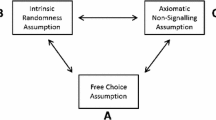Abstract
A recent paper from Brun et al. has argued that access to a closed timelike curve (CTC) would allow for the possibility of perfectly distinguishing nonorthogonal quantum states. This result can be used to develop a protocol for instantaneous nonlocal signaling. Several commenters have argued that nonlocal signaling must fail in this and in similar cases, often citing consistency with relativity as the justification. I argue that this objection fails to rule out nonlocal signaling in the presence of a CTC. I argue that the reason these authors are motivated to exclude the prediction of nonlocal signaling is because the No Signaling principle is considered to a fundamental part of the formulation of the quantum information approach. I draw out the relationship between nonlocal signaling, quantum information, and relativity, and argue that the principle theory formulation of quantum mechanics, which is at the foundation of the quantum information approach, is in tension with foundational assumptions of Deutsch’s D-CTC model, on which this protocol is based.




Similar content being viewed by others
Notes
In fact, Gisin (1990) showed that a more general nonlinear framework would allow for the same behavior.
Because the procedure involves taking the partial trace of the system, and requiring consistency for only the state of the system bound to the CTC, any entanglement with systems in CR region is broken when the CTC-bound quibit exits the past mouth of the CTC.
Deutsch admits that discreteness in the classical domain is an approximation, so perhaps an argument could be made that the fixed point of such a system would involve a failure of the gate to operate properly. But assuming everything works as advertised, there is no classical fixed point.
As is true in the classical case, most fixed-point solutions in the D-CTC model are not unique. However, the information flow in this circuit is at the heart of the Grandfather Paradox, and is therefore especially important for Deutsch’s goal to show that his model can solve the paradoxes of time travel. The BHW circuit, with which we will be concerned in the following section, also has a unique fixed-point solution.
The Hadamard transform is \(\frac{1}{\sqrt{2}}\left( \begin{array}{cc} 1 &{}\quad 1\\ 1&{}\quad -1 \end{array} \right). \)
Maudlin’s “case-1” signals are the most general case of superluminal signals, as they are not confined to a single reference frame.
The simple objection that superluminal signaling would violate relativity because the information is “traveling faster than light” can be answered by pointing out that there is nothing about exploiting quantum nonlocality to sent usable information that requires that a carrier of information physically traverses the space between the communicating parties. Quantum teleportation arguably involves sending quantum information (in the form of the unknown state \(|\psi \rangle \)) faster than light from Alice to Bob, though in order for Bob to use it, a two-bit classical message must be sent at subluminal speeds. See Timpson’s (2013) discussion of teleportation.
There is a related result that suggests that Deutsch’s solution to a simple Grandfather Paradox circuit would not hold if he weren’t explicitly relying on the MSM structure. See Dunlap (2016).
References
Barrett, J. (2007). Information processing in generalized probabilistic theories. Physical Review A, 75(3), 032304.
Bennett, C. H., Leung, D., Smith, G., & Smolin, J. A. (2009). Can closed timelike curves or nonlinear quantum mechanics improve quantum state discrimination or help solve hard problems? Physical Review Letters, 103, 170502.
Brun, T. A., Harrington, J., & Wilde, M. M. (2009). Localized closed timelike curves can perfectly distinguish quantum states. Physical Review Letters, 102, 210402.
Bub, J., & Pitowsky, I. (2010). Many worlds? Everett, quantum theory, and reality. In S. Saunders, J. Barrett, A. Kent, & D. Wallace (Eds.), Two dogmas about quantum mechanics (pp. 433–459). Oxford: Oxford University Press. chap. 14.
Bub, J., & Stairs, A. (2014). Quantum interactions with closed timelike curves and superluminal signaling. Physical Review A, 89(2), 022311.
Cavalcanti, E. G., & Menicucci, N. C. (2010). Verifiable nonlinear quantum evolution implies failure of density matricies to represent proper mixtures. arXiv:1004.1219v4 [quant-ph].
Cavalcanti, E. G., Menicucci, N. C., & Pienaar, J. L. (2012). The preparation problem in nonlinear extensions of quantum theory. arXiv:1206.2725v1 [quant-ph].
Deutsch, D. (1991). Quantum mechanics near closed timelike lines. Physical Review D, 44(10), 3197–3217.
Deutsch, D., & Lockwood, M. (1994). The quantum physics of time travel. Scientific American, 270(3), 50–56.
Dunlap, L. (2016). The metaphysics of D-CTCs: On the underlying assumptions of Deutsch’s quantum solution to the paradoxes of time travel. Studies in the History and Philosophy of Modern Physics, 56, 39–47.
Earman, J., Smeenk, C., & Wüthrich, C. (2009). Do the laws of physics forbid the operation of time machines? Synthese, 169, 91–124.
Gisin, N. (1990). Weinberg’s non-linear quantum mechanics and supraluminal communications. Physics Letters A, 143(1.2), 1–2.
Gisin, N. (2013). Quantum correlations in Newtonian space and time: Arbitrarily fast communication or nonlocality (2012). In D. Struppa & J. Tollaksen (Eds.), Quantum theory: A two time success story (pp. 185–203). Dordrecht, NL: Springer.
Lewis, D. (1976). The paradoxes of time travel. American Philosophical Quarterly, 13(2), 145–152.
Maudlin, T. (2011). Quantum non-locality and relativity (3rd ed.). Chichester: Wiley-Blackwell.
Norton, J. D. (2013). Einstein for everyone. Nullarbor Press (Online).
Novikov, I. (2002). Can we change the past? In: The future of spacetime (pp. 57–86). New York, NY: Norton.
Pawłowski, M., Paterek, T., Kaszlikowski, D., Scarani, V., Winter, A., & Żukowski, M. (2009). Information causality as a physical principle. Nature, 461(7267), 1101–1104.
Timpson, C. (2013). Quantum information theory and the foundations of quantum mechanics. Oxford: Oxford University Press.
Acknowledgements
Funding was provided by Division of Social and Economic Sciences (Grant No. 1431229).
Author information
Authors and Affiliations
Corresponding author
Rights and permissions
About this article
Cite this article
Dunlap, L. Would the Existence of CTCs Allow for Nonlocal Signaling?. Erkenn 84, 215–234 (2019). https://doi.org/10.1007/s10670-017-9955-6
Received:
Accepted:
Published:
Issue Date:
DOI: https://doi.org/10.1007/s10670-017-9955-6




